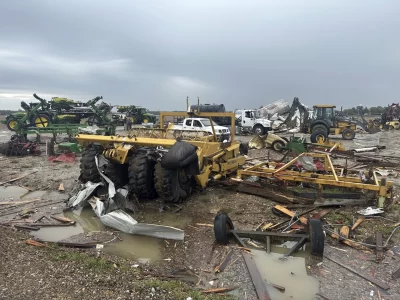
A blanket of bright green alfalfa spreads across western Arizona’s McMullen Valley, ringed by rolling mountains and warmed by the hot desert sun.
Matthew Hancock’s family has used groundwater to grow forage crops here for more than six decades. They’re long accustomed to caprices of Mother Nature that can spoil an entire alfalfa cutting with a downpour or generate an especially big yield with a string of blistering days.
But concerns about future water supplies from the valley’s ancient aquifers, which hold groundwater supplies, are bubbling up in Wenden, a town of around 700 people where the Hancock family farms.
It is unknown how much water the Al Dahra operation uses, but Hancock estimates it needs 15,000 to 16,000 acre feet a year based on what his own alfalfa farm needs. He says he gets all the water he needs by drilling down hundreds of feet. An acre-foot of water is roughly enough to serve two to three U.S. households annually.
Hancock said he and neighbors with larger farms worry more that in the future state officials could take control of the groundwater they now use for agriculture and transfer it to Phoenix and other urban areas amid the worst Western drought in centuries.
“I worry about the local community farming in Arizona,” Hancock said, standing outside an open-sided barn stacked with hay bales.
Concerns about the Earth’s groundwater supplies are front of mind in the lead-up to COP28, the annual United Nations climate summit opening this week in the Emirati city of Dubai. Gulf countries like the UAE are especially vulnerable to global warming, with high temperatures, arid climates, water scarcity and rising sea levels.
“Water shortages have driven companies to go where the water is,” said Robert Glennon, a water policy and law expert and professor emeritus at the University of Arizona.
Experts say tensions are inevitable as companies in climate-challenged countries like the United Arab Emirates increasingly look to faraway places like Arizona for the water and land to grow forage for livestock and commodities such as wheat for domestic use and export.
“As the impacts of climate change increase, we expect to see more droughts,” said Karim Elgendy, a climate change and sustainability specialist at Chatham House think tank in London. “This means more countries would look for alternative locations for food production.”
Without groundwater pumping regulations, rural Arizona is especially attractive, said Elgendy, who focuses on the Middle East and North Africa. International corporations have also turned to Ethiopia and other parts of Africa to develop enormous farming operations criticized as “land grabbing.”
La Paz County Supervisor Holly Irwin welcomes a recent crackdown by Arizona officials on unfettered groundwater pumping long allowed in rural areas, noting local concerns about dried up wells and subsidence that’s created ground fissures and flooding during heavy rains.
“You’re starting to see the effects of lack of regulation,” she said. “Number one, we don’t know how much water we have in these aquifers, and we don’t know how much is being pumped out.”
Irwin laments that foreign firms are “mining our natural resource to grow crops such as alfalfa … and they’re shipping it overseas back to their country where they’ve depleted their water source.”
Gary Saiter, board chairman and general manager of the Wenden Domestic Water Improvement District, said utility records showed the surface-to-water depth at its headquarters was a little over 100 feet (30 meters) in the 1950s, but it’s now now about 540 feet (160 meters).
Saiter said that over those years, food crops like cantaloupe have been replaced with forage like alfalfa, which is water intensive.
“I believe that the legislature in the state needs to step up and actually put some control, start measuring the water that the farms use,” Saiter said.






